Serendip is an independent site partnering with faculty at multiple colleges and universities around the world. Happy exploring!
Resources for Teaching about Coronavirus - December 2020
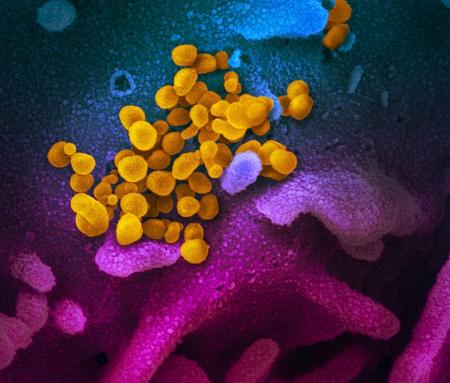
ARCHIVED PAGE
Please see: this Teaching Resources page for current information.
Our understanding of the novel coronavirus and the COVID-19 pandemic continues to change rapidly. The following resources for teaching high school biology students are up-to-date as of mid-November, 2020.1 On this page:
Learning Activities
Coronaviruses – What They Are and How They Can Make You Sick
https://serendipstudio.org/exchange/bioactivities/coronavirusintro
This analysis and discussion activity introduces students to the novel coronavirus and the disease it causes. Students learn how coronaviruses are replicated, analyze how the respiratory and circulatory systems work together to provide oxygen to the body’s cells, and learn about the immune responses to coronavirus infection. This provides the basis for students to understand how a coronavirus infection can cause mild temporary illness or serious and even fatal illness.
Changing Recommendations about How to Reduce Your Risk of Coronavirus Infection – What is the evidence?https://serendipstudio.org/exchange/bioactivities/coronavirusprev
In this analysis and discussion activity, students learn about the scientific basis of recommendations to reduce the spread of coronavirus infections. They analyze how changes in the recommendations resulted from new research findings about the behaviors and situations that increase or decrease the risk of coronavirus infection.
Where did the new coronavirus come from?
https://serendipstudio.org/exchange/bioactivities/coronavirusOrigin
In this analysis and discussion activity, students explore the main hypotheses about the origins of the new coronavirus that is causing the current pandemic. Students learn how mutations, natural selection, and contact between species can work together to produce a spillover infection. They analyze how a previous coronavirus spillover infection caused an earlier outbreak of human infectious disease. Molecular evidence is presented for students to evaluate the hypothesis that genetic engineering produced the new coronavirus. In addition, students explore possible strategies for preventing new spillover infections.
COVID-19 Curriculum Materials
https://epiclearning.web.unc.edu/covid/
In the most relevant of the three activities, students use a mathematical model, programmed within a spreadsheet (Google Sheets), to explore viral transmission and exponential growth. It enables comparisons of viruses with different reproduction numbers (R0) numerically and graphically. This activity challenges students to think through various implications of the model and to consider strategies for reducing R0 for a virus and the associated impacts and viral transmission. Another suggested activity is designed to improve media literacy.
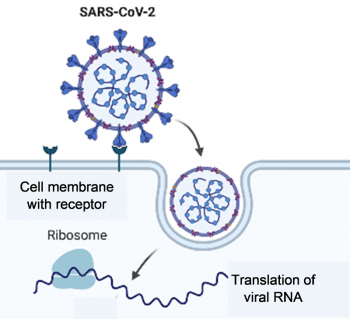 How Genes Can Cause Disease – Understanding Transcription and Translation
How Genes Can Cause Disease – Understanding Transcription and Translation
https://serendipstudio.org/exchange/bioactivities/trans
After students learn about the processes of transcription and translation, students use their understanding of translation to develop a partial explanation of how the coronavirus replicates inside our cells.
Information Sources
How to Turn Information Sources into Learning Activities
You can convert the information sources listed below to learning activities by providing your students with appropriate questions. A more ambitious approach would be to use the following steps to carry out a jigsaw activity using several of the articles.2
- Tell your class that they will read one article in their small group, summarize the main conclusions and evidence, and then share this information with a group of students who have read other articles.
- As students complete the reading individually, each of them should prepare a summary and possibly annotate the article and/or answer any questions that you may have prepared.
- Have students who read the same article briefly share their findings with one another and discuss the article. This will help students prepare to briefly summarize their article in the mixed group.
- Regroup students so that one representative from each article is in each group. Ask students to briefly summarize their articles in their new groups. When sharing the summaries, students should make connections to what they have heard in the other students’ summaries. They should talk through anything that is unclear or seems inconsistent from one article to the next. Students should take notes during this sharing, listening, and discussion process.
- The whole class then discusses the main takeaways from the jigsaw reading. Ask students what questions they are still wondering about and try to follow up.
Basic Biology of Coronavirus Infection
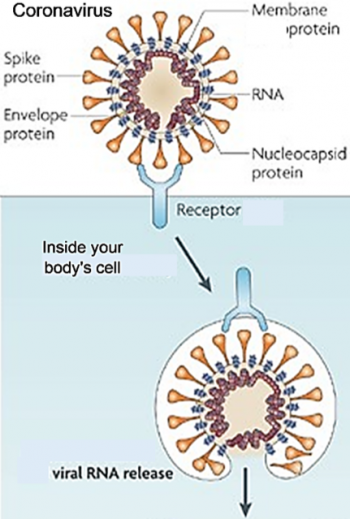
How Coronavirus Hijacks Your Cells
https://www.nytimes.com/interactive/2020/03/11/science/how-coronavirus-hijacks-your-cells.html
This graphical webpage explains how the coronavirus infects your cells and is reproduced inside your cells.
What actually happens if you get coronavirus?
https://www.youtube.com/watch?v=OTYfke545vI
The first 4 minutes and 45 seconds of this video provide a good introduction to the novel coronavirus and Covid-19. The later part of the video is not recommended because recent research has revealed that several points included in this section are not accurate.
What Happens If You Get Coronavirus
https://www.youtube.com/watch?v=5DGwOJXSxqg
This 8-minute video explains how coronavirus infects cells, how pneumonia develops, and how scientists are working to develop a vaccine.
Inside the Coronavirus
https://www.scientificamerican.com/interactive/inside-the-coronavirus/
This link provides an excellent graphic presentation about viral structure, replication and immune responses.
The Coronavirus Unveiled
https://www.nytimes.com/interactive/2020/health/coronavirus-unveiled.html?referringSource=articleShare
This article includes detailed descriptions and graphics with recent evidence about the structure of the novel coronavirus.
Bad News Wrapped in Protein: Inside the Coronavirus Genome
https://www.nytimes.com/interactive/2020/04/03/science/coronavirus-genome-bad-news-wrapped-in-protein.html
This graphical webpage explains the function of each of the viral proteins.
Coronavirus: How It Infects Us and How We Might Stop It
https://www.scientificamerican.com/video/coronavirus-how-it-infects-us-and-how-we-might-stop-it/
The first 52 minutes of this video provide a clear and detailed description of molecular biology of coronavirus, the immune response to coronavirus infection, how the coronavirus resists the coronavirus infection, and vaccine development.
Could my symptoms be Covid 19?
https://www.nytimes.com/interactive/2020/08/05/well/covid-19-symptoms.html
This graphic summarizes the effects of coronavirus infection on multiple parts of the body.
Testing and Preventing Coronavirus Infection
The Science Behind How Coronavirus Tests Work
https://www.pbs.org/wgbh/nova/video/how-coronavirus-tests-work/
This 7-minute video explains the science behind the various types of coronavirus tests.
Fast coronavirus tests: what they can and can’t do
https://www.nature.com/articles/d41586-020-02661-2
This mid-September article discusses the pros and cons of PCR tests, rapid antigen tests and antibody tests.
Your coronavirus test is positive. Maybe it shouldn’t be.
https://www.nytimes.com/2020/08/29/health/coronavirus-testing.html
The PCR test can detect very low levels of coronavirus. The highly sensitive threshold for a positive test used in the US means that many people who test positive for coronavirus infection probably are not contagious.
Coronavirus Antibody Tests Have a Mathematical Pitfall
https://www.scientificamerican.com/article/coronavirus-antibody-tests-have-a-mathematical-pitfall/
All tests have at least some false positives and false negatives, and the rate of false positives can be high when the infection rate is low.
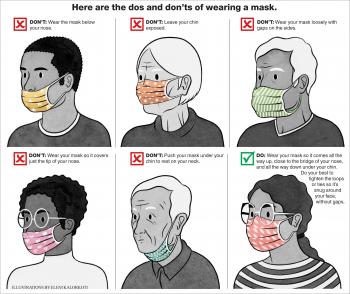 Viruses in the Air
Viruses in the Air
https://www.youtube.com/watch?v=f57LXUbrtPU
This 2.5-minute video explains how people transmit viral infections like coronavirus and influenza. Transmission probably occurs by multiple routes, but we don’t know how much transmission occurs by touching surfaces, breathing in these viruses, or having them land on eyes, nose or mouth.
How Coronavirus Spreads Outdoors vs. Indoors
https://www.youtube.com/watch?v=n6QwnzbRUyA
This 6-minute video does an excellent job of explaining the science behind recommendations for reducing one’s risk of coronavirus infection. Dose of coronavirus can be reduced by keeping at least 6 feet distance from people outside your family, limiting the duration of interaction, wearing masks, and interacting in places with good ventilation, particularly outdoors where UV radiation can inactivate viruses.
Everyone Thinks They’re Right about Masks
https://www.theatlantic.com/health/archive/2020/04/coronavirus-pandemic-airborne-go-outside-masks/609235/
This informative article explains the reasons behind the shifting advice concerning the importance of masks for slowing the spread of COVID-19.
The Risks – Know Them – Avoid Them
https://www.erinbromage.com/post/the-risks-know-them-avoid-them
This article provides a readable account of the evidence concerning how people have been infected with the coronavirus. 90% of transmission events occurred indoors with people closely spaced, with lots of talking, singing or shouting.
There’s more to COVID safety than 6 feet of social distance. Here’s what else to consider.
https://www.inquirer.com/health/coronavirus/coronavirus-social-distancing-rules-outdated-rigid-bmj-paper-20200902.html
This article includes a helpful graphic showing how risk of infection varies depending on multiple factors, including location indoors vs. outdoors, amount of ventilation, how long you spend in the location, how many people are in the location, and whether these people are wearing face coverings and silent, speaking, shouting or singing.
Videos that explain why washing your hands with soap is effective in fighting coronavirus infection:
- The 2-minute video “Fighting Coronavirus with Soap” (https://www.youtube.com/watch?v=s2EVlqql_f8) provides a good explanation of how soap breaks down the phospholipid bilayer of the viral envelope, so the coronavirus falls apart.
- The 6-minute video, “Which is Better: Soap or Hand Sanitizer?” (https://www.youtube.com/watch?v=x7KKkElpyKQ) provides a more in-depth explanation; if you use this video, make sure your students understand that hand sanitizer needs to have at least 60% ethanol or 70% isopropanol to be effective.
- The 1.5-minute video, “WHO: How to handwash? With soap and water” (https://www.youtube.com/watch?v=3PmVJQUCm4E) demonstrates how to wash your hands effectively.
Coronavirus (COVID-19)
https://www.cdc.gov/coronavirus/2019-ncov/index.html
This website provides reliable information on how to prevent infection, the symptoms of COVID-19, and what to do if you are sick. A lot of helpful practical advice is available at https://www.cdc.gov/coronavirus/2019-ncov/faq.html. "How to Select, Wear and Clean Your Mask” is available at https://www.cdc.gov/coronavirus/2019-ncov/prevent-getting-sick/about-face-coverings.html.
The race for coronavirus vaccines: a graphical guide
https://www.nature.com/articles/d41586-020-01221-y
This article summarizes the immune responses against viruses and the different approaches being used to try to develop a vaccine against the novel coronavirus.
New Pfizer Results: Coronavirus Vaccine Is Safe and 95% Effective
https://www.nytimes.com/2020/11/18/health/pfizer-covid-vaccine.html
Moderna coronavirus vaccine trial produces best results yet
https://www.newscientist.com/article/2259939-moderna-coronavirus-vaccine-trial-produces-best-results-yet/
These two articles describe very promising results about the efficacy and safety of these two mRNA vaccines.
Spread of the COVID-19 Pandemic
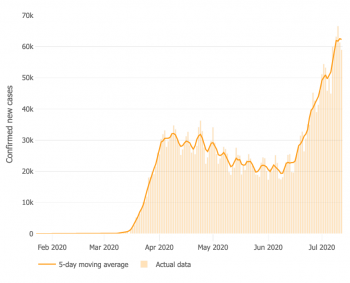
How to Tell If We’re Beating COVID-19.
https://www.realclearscience.com/video/2020/03/28/how_to_tell_if_were_beating_covid-19.html
This 7-minute video presents an informative analysis of exponential growth and deviations from exponential growth that indicate effective actions to stop exponential growth in some countries.
Why outbreaks like coronavirus spread exponentially, and how to “flatten the curve”
https://www.washingtonpost.com/graphics/2020/world/corona-simulator/
This article includes a simulator that predicts the effects of attempting to quarantine ill individuals vs. social distancing by different proportions of the population.
This Overlooked Variable Is the Key to the Pandemic
https://www.theatlantic.com/health/archive/2020/09/k-overlooked-variable-driving-pandemic/616548/
This article emphasizes that COVID-19 generally spreads in clusters of infections that result from superspreading events in poorly ventilated, crowded conditions. The author explains the implications for how contact tracing should be done.
The World Is Still Far from Herd Immunity for Coronavirus
https://www.nytimes.com/interactive/2020/05/28/upshot/coronavirus-herd-immunity.html
This article compares the prevalence of coronavirus antibodies in May in various cities with the estimated 60% of the population needed to provide herd immunity. It also discusses the limitations of the concept of herd immunity.
Covid-19 Herd Immunity Is Much Closer Than Antibody Tests Suggest, Say 2 New Studies
https://reason.com/2020/07/01/covid-19-herd-immunity-is-much-closer-than-antibody-tests-suggest-say-2-new-studies/
with
Pre-existing immunity to SARS-CoV-2: the knowns and unknowns
https://www.nature.com/articles/s41577-020-0389-z
Research studies find T-cell immunity against the coronavirus in quite a few people who do not have antibodies. These studies need to be supplemented by studies with larger samples and studies of the effectiveness of T-cell immunity.
Where did the new coronavirus come from?
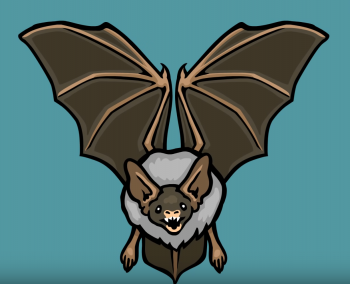 Where do new viruses come from?
Where do new viruses come from?
https://www.youtube.com/watch?v=NJLXdsO1GBI.
This Stated Clearly video does a good job of explaining how mutation and natural selection can start with a virus that infects a non-human animal and produce a virus that infects humans, thus resulting in a new human infectious disease.
The coronavirus was not engineered in a lab. Here's how we know.
https://www.livescience.com/coronavirus-not-human-made-in-lab.html
This article provides a concise description of the evidence that the new coronavirus was not made in a lab.
Ongoing Sources of Reliable New Information
Reliable sources of new information include:
- Coronavirus (COVID-19) (https://www.cdc.gov/coronavirus/2019-ncov/index.html)
- Science (https://www.sciencenews.org/editors-picks/2019-novel-coronavirus-outbreak)
- New York Times (https://www.nytimes.com/news-event/coronavirus)
- FAS COVID-19 – Ask a Scientist (https://covid19.fas.org/).
1 Previously provided resources are available at Archived.
2 These instructions are adapted from https://www.nsta.org/science-teacher/science-teacher-march-2020/novel-coronavirus.











Comments
Post new comment